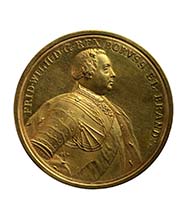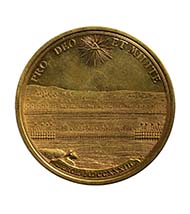Parade of the “Lange Kerls” (Long Guys)
by courtesy of the Berlin Coin Cabinet
on the occasion of its exhibit “Gold Giants”
Frederick William I of Prussia is popularly known as the “Soldier-King”. One objective of his reign was the constitution of a “formidable” army, the other one was “making plus” – both had to be done »cito, cito« (quick, quick). On the other hand, he was a “King of saving” with a frugal personal living and a self-understanding as first servant of the “King in Prussia”.
Representational medal of 100 ducats, 1733. Frederick William I King in Prussia (1713 -1740), medallist Peter Paul Werner (Nuremberg 1689 -1771 Nuremberg), gold, 348.64 g, 87 mm, 12 o’clock. Vienna Coin Cabinet, inv. 86 bß.
His fondness of particularly huge soldiers, the “Lange Kerls” (Long Guys), was often sneered at but he tested his drill book and military innovations on this guard of giants stationed in Potsdam before applying it to the army as a whole. He himself was one of the most peace-loving Prussian regents. His son and successor Frederick II on his part utilized the Prussian army, shaped by his father and soon feared in Europe because of its perfection, immediately after his government takeover to seize Silesia.
The Soldier-King annually conducted big parades on the Tempelhofer Feld in Berlin to canvass his troops’ qualification. In celebration of the parades of 1719, 1728 and 1733 medals were produced that reflect the King’s love of big things: they range amongst the biggest struck medals ever produced. The King being economical only few examples were manufactured which were all made of silver – this one is the only one made of gold and, at the same time, one of the biggest gold pieces of Brandenburg-Prussia. Slightly heavier are just the two medals on the occasion of the victory over Austria in 1866 and France in 1871, respectively.
This gold giant can be viewed in the exhibit of the Berlin Coin Cabinet bearing the same title. For more information click here.










